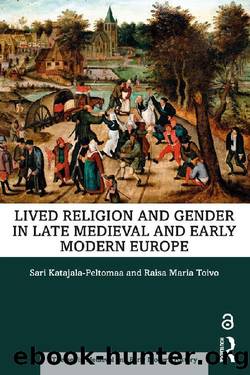Lived Religion and Gender in Late Medieval and Early Modern Europe (Themes in Medieval and Early Modern History) by Sari Katajala-Peltomaa & Raisa Maria Toivo

Author:Sari Katajala-Peltomaa & Raisa Maria Toivo [Katajala-Peltomaa, Sari & Toivo, Raisa Maria]
Language: eng
Format: epub
ISBN: 9781138544550
Publisher: Taylor and Francis
Published: 2020-11-22T23:00:00+00:00
Lay people talking about religion
Religion was a social process connecting individuals and communities; it was played out within the web of power relations inherent in medieval society, as the example of Hans Smek demonstrates. It was, however, only one of the many processes, and the interconnection of religion and political power is well established. Religious and secular life were inseparable in the Middle Ages and early modern period. The churchâs main sphere was religion, but it was also involved in public life. Crises, be they personal, such as family emergencies, or communal, such as the Reformation, the wars of religions or other symbolic peaks of change, often forced a merger of the private and the public for those involved.
Laypeople did have a need and desire to discuss religious matters, as is demonstrated by the rise of lay preachers during the Reformations. The ability to teach and preach gave a person great religious power â perhaps even too great a power, because all Protestants soon started to take a very uncomplimentary attitude towards these expressions of general priesthood. Laypeople in general were supposed to read religious writings, but not preach, teach or interpret them. Luther especially assumed this stance soon after the German Peasantsâ War, which had clearly shown that society was not ready for laypeople to become teachers. All reformers were unanimous about women preachers contravening the teachings found in Paulâs letters; women were supposed to be silent parishioners and obey their husbands. Laymen preachers were almost as suspect as women preachers. Preaching was only a part of clerical authority and masculinity, and in the matters of faith, laymen were also listeners.
The Reformations created more space for the public side of religion. Individuals, groups and political and religious parties tried to shape customs and institutions to better support their views and persuade or force others to join them. In the Middle Ages, overseeing peopleâs religious life mainly concerned the clergy, but during the widespread disagreements of the Reformation era, it became everyoneâs concern. In various parts of Europe, this resulted in unrest, riots and even rebellion. Protestants destroyed pictures, paintings, statues, altars and even churches that Catholics held holy, and Catholics rioted just as violently in defending their sacred spaces and holy items. This often resulted in both camps destroying property belonging not only to the church but also to the broader populace.
In both Catholic and Protestant areas, laypeople also engaged in public displays of faith, especially in the early stages of religious change; they taught and preached. In the medieval church, laypeople â men and women alike â were explicitly banned from preaching. However, prophesying mystics could evade this ban by talking about their visions, as they came directly from God. Attitudes towards lay womenâs speech and words had been problematic ever since early Christianity, despite the public speaking of women being depicted approvingly in the Bible. It was a woman who delivered the most important message at Easter: Mary Magdalene had found the empty grave on Easter morning and informed the disciples.
Download
This site does not store any files on its server. We only index and link to content provided by other sites. Please contact the content providers to delete copyright contents if any and email us, we'll remove relevant links or contents immediately.
Jesus Wars: How Four Patriarchs, Three Queens, and Two Emperors Decided What Christians Would Believe for the Next 1,500 Years by John Philip Jenkins(114)
The Writings of Henry Barrow, 1590-91 by Leland H. Carlson(114)
A History of Liturgical Books by Palazzo Eric(114)
The Virgin by Ashe Geoffrey(110)
The Decline of Established Christianity in the Western World by Peterson Paul Silas(106)
Dark mysteries of the vatican by H. Paul Jeffers(103)
Church, State and Dynasty in Renaissance Poland: The Career of Cardinal Fryderyk Jagiellon (1468-1503) by Natalia Nowakowska(100)
The Rhetorical Leadership of Fulton J. Sheen, Norman Vincent Peale, and Billy Graham in the Age of Extremes by Sherwood Timothy H.;(100)
The Pietist Impulse in Christianity by Christian T. Collins Winn(96)
Crusaders, Cathars and the Holy Places by Hamilton Bernard;(94)
In Discordance with the Scriptures: American Protestant Battles Over Translating the Bible (Religion in America) by Peter J. Thuesen(88)
Intimacy and Exclusion by Dagmar Herzog(85)
The Origins of Southern Evangelicalism by Little Thomas J.;(85)
Holy Matter by Sara Ritchey(82)
Parish Boundaries by John T. McGreevy(76)
Lonely Mystic : A New Portrait of Henri J. M. Nouwen by Michael Ford(73)
Rufinus of Aquileia: History of the Church by Rufus of Aquileia (Author) & Philip R. Amidon (Translator)(67)
Catholic Gentry in English Society: The Throckmortons of Coughton from Reformation to Emancipation by Peter Marshall Geoffrey Scott (eds.)(65)
The Eastern Churches Trilogy: The Orthodox Eastern Church by Adrian Fortescue(61)
